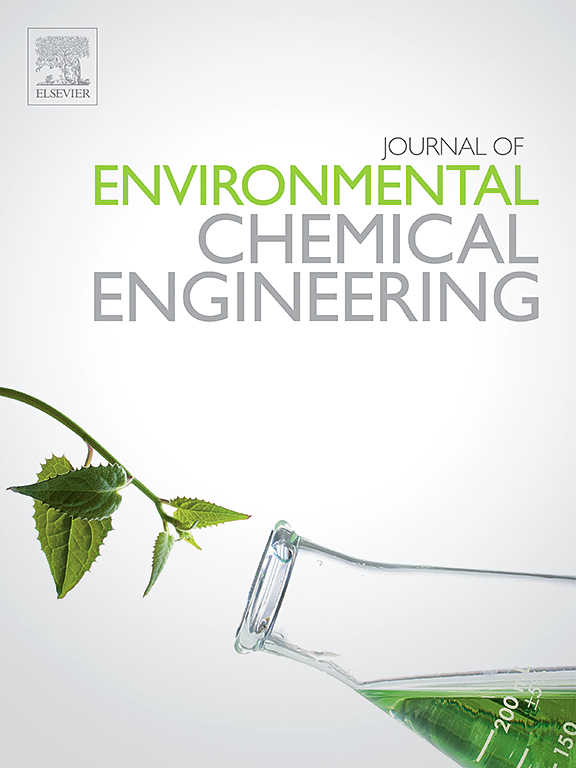Synthesis of bifunctional copolymeric nanofibers with selective extracting U(VI) from the solution and antibacterial property
IF 7.4
2区 工程技术
Q1 ENGINEERING, CHEMICAL
引用次数: 0
Abstract
Facing the problem of future nuclear fuel shortage, developing high-performance adsorbent materials is key. In this work, the amidoxime group/imidazole functionalized ionic liquid copolymer fibers containing bromide salts, and fluoroborate salts (namely P(AO/VEIMBr)8 and P(AO/VEIMBF4)6) were prepared by a one-pot method and free radical polymerization, hydroxyl amination reaction and electrostatic spinning, and characterized by SEM, FT-IR, and 1 H NMR. The influence of solid-liquid ratio, ionic strength, and adsorption time on the adsorption performance was investigated by batch adsorption experiments. In the meanwhile, the adsorption kinetics and thermodynamic processes of U(VI) on the copolymer fibers was also studied. Adsorption mechanism of U (VI) on polymer fibers was explored by XPS spectroscopic analysis combined with DFT method. Finally, the antimicrobial properties of the copolymer fibers were tested. The experimental results showed that the polymer nanofibers synthesized for U(VI) has a fast adsorption, high adsorption capacity at ionic strength close to seawater, and excellent reusability. The adsorption process conformed to the pseudo-second-order kinetic model and Langmuir model, which indicated that chemical adsorption and monolayer adsorption are dominant for adsorption U(VI) on the polymer nanofibers, and exhibits the highest Uranium adsorption capacity (76.92 mg/g and 81.96 mg/g at pH=8.1+0.1, respectively). XPS result showed the amine nitrogen and oxime oxygen in the amidoxime functional group were coordinated with uranyl(VI) ions. The antibacterial experiments showed that the copolymer fibers have antimicrobial properties and the antibacterial rate is over 90 %. Therefore, the nanofibers may be a promising material for extracting uranium from the weak alkaline wastewater or seawater.
从溶液中选择性提取铀(VI)并具有抗菌性能的双功能共聚纳米纤维的合成
面对未来核燃料短缺的问题,开发高性能吸附材料是关键所在。本研究采用一锅法,通过自由基聚合、羟基胺化反应和静电纺丝制备了含溴盐和氟硼酸盐的脒肟基/咪唑功能化离子液体共聚纤维(即 P(AO/VEIMBr)8 和 P(AO/VEIMBF4)6),并利用扫描电镜、傅立叶变换红外光谱和 1 H NMR 对其进行了表征。通过批次吸附实验研究了固液比、离子强度和吸附时间对吸附性能的影响。同时,还研究了 U(VI)在共聚物纤维上的吸附动力学和热力学过程。通过 XPS 光谱分析结合 DFT 方法探讨了 U(VI)在聚合物纤维上的吸附机理。最后,测试了共聚物纤维的抗菌性能。实验结果表明,合成的聚合物纳米纤维对铀(Ⅵ)具有快速吸附的特性,在离子强度接近海水的情况下吸附能力强,并且具有良好的重复使用性。吸附过程符合伪二阶动力学模型和 Langmuir 模型,表明聚合物纳米纤维对铀(Ⅵ)的吸附以化学吸附和单层吸附为主,并表现出最高的铀吸附容量(pH=8.1+0.1 时分别为 76.92 mg/g 和 81.96 mg/g)。XPS 结果表明,脒肟官能团中的胺氮和肟氧与铀酰(VI)离子配位。抗菌实验表明,共聚物纤维具有抗菌性能,抗菌率超过 90%。因此,纳米纤维可能是一种很有前途的从弱碱性废水或海水中提取铀的材料。
本文章由计算机程序翻译,如有差异,请以英文原文为准。
求助全文
约1分钟内获得全文
求助全文
来源期刊

Journal of Environmental Chemical Engineering
Environmental Science-Pollution
CiteScore
11.40
自引率
6.50%
发文量
2017
审稿时长
27 days
期刊介绍:
The Journal of Environmental Chemical Engineering (JECE) serves as a platform for the dissemination of original and innovative research focusing on the advancement of environmentally-friendly, sustainable technologies. JECE emphasizes the transition towards a carbon-neutral circular economy and a self-sufficient bio-based economy. Topics covered include soil, water, wastewater, and air decontamination; pollution monitoring, prevention, and control; advanced analytics, sensors, impact and risk assessment methodologies in environmental chemical engineering; resource recovery (water, nutrients, materials, energy); industrial ecology; valorization of waste streams; waste management (including e-waste); climate-water-energy-food nexus; novel materials for environmental, chemical, and energy applications; sustainability and environmental safety; water digitalization, water data science, and machine learning; process integration and intensification; recent developments in green chemistry for synthesis, catalysis, and energy; and original research on contaminants of emerging concern, persistent chemicals, and priority substances, including microplastics, nanoplastics, nanomaterials, micropollutants, antimicrobial resistance genes, and emerging pathogens (viruses, bacteria, parasites) of environmental significance.
 求助内容:
求助内容: 应助结果提醒方式:
应助结果提醒方式:


